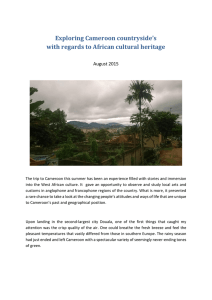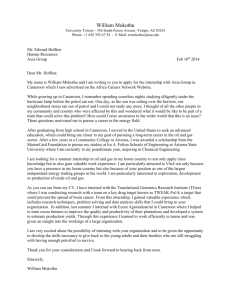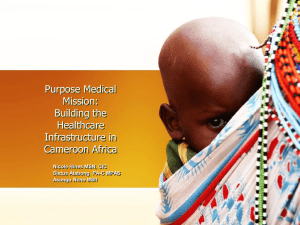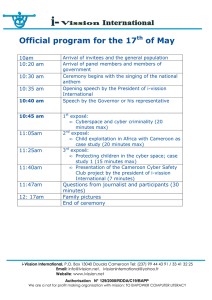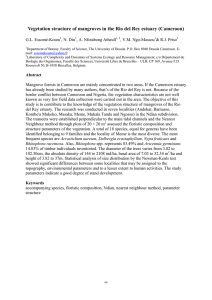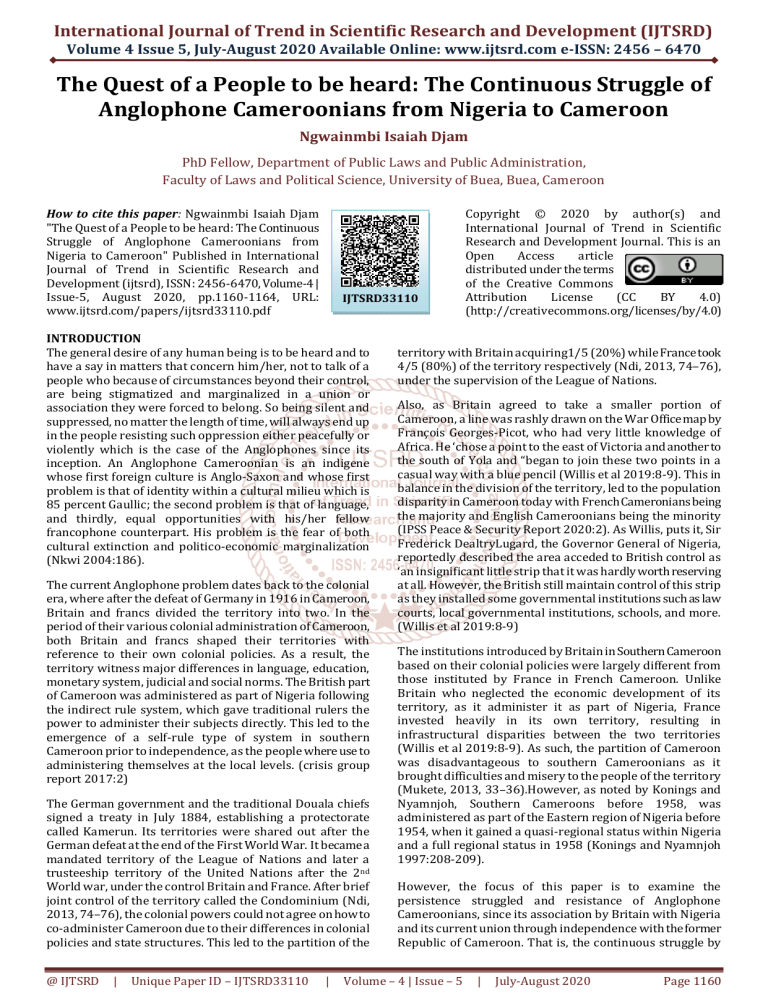
International Journal of Trend in Scientific Research and Development (IJTSRD)
Volume 4 Issue 5, July-August 2020 Available Online: www.ijtsrd.com e-ISSN: 2456 – 6470
The Quest of a People to be heard: The Continuous Struggle of
Anglophone Cameroonians from Nigeria to Cameroon
Ngwainmbi Isaiah Djam
PhD Fellow, Department of Public Laws and Public Administration,
Faculty of Laws and Political Science, University of Buea, Buea, Cameroon
How to cite this paper: Ngwainmbi Isaiah Djam
"The Quest of a People to be heard: The Continuous
Struggle of Anglophone Cameroonians from
Nigeria to Cameroon" Published in International
Journal of Trend in Scientific Research and
Development (ijtsrd), ISSN: 2456-6470, Volume-4 |
Issue-5, August 2020, pp.1160-1164, URL:
www.ijtsrd.com/papers/ijtsrd33110.pdf
IJTSRD33110
INTRODUCTION
The general desire of any human being is to be heard and to
have a say in matters that concern him/her, not to talk of a
people who because of circumstances beyond their control,
are being stigmatized and marginalized in a union or
association they were forced to belong. So being silent and
suppressed, no matter the length of time, will always end up
in the people resisting such oppression either peacefully or
violently which is the case of the Anglophones since its
inception. An Anglophone Cameroonian is an indigene
whose first foreign culture is Anglo-Saxon and whose first
problem is that of identity within a cultural milieu which is
85 percent Gaullic; the second problem is that of language,
and thirdly, equal opportunities with his/her fellow
francophone counterpart. His problem is the fear of both
cultural extinction and politico-economic marginalization
(Nkwi 2004:186).
The current Anglophone problem dates back to the colonial
era, where after the defeat of Germany in 1916 in Cameroon,
Britain and francs divided the territory into two. In the
period of their various colonial administration of Cameroon,
both Britain and francs shaped their territories with
reference to their own colonial policies. As a result, the
territory witness major differences in language, education,
monetary system, judicial and social norms. The British part
of Cameroon was administered as part of Nigeria following
the indirect rule system, which gave traditional rulers the
power to administer their subjects directly. This led to the
emergence of a self-rule type of system in southern
Cameroon prior to independence, as the people where use to
administering themselves at the local levels. (crisis group
report 2017:2)
The German government and the traditional Douala chiefs
signed a treaty in July 1884, establishing a protectorate
called Kamerun. Its territories were shared out after the
German defeat at the end of the First World War. It became a
mandated territory of the League of Nations and later a
trusteeship territory of the United Nations after the 2nd
World war, under the control Britain and France. After brief
joint control of the territory called the Condominium (Ndi,
2013, 74–76), the colonial powers could not agree on how to
co-administer Cameroon due to their differences in colonial
policies and state structures. This led to the partition of the
@ IJTSRD
|
Unique Paper ID – IJTSRD33110
|
Copyright © 2020 by author(s) and
International Journal of Trend in Scientific
Research and Development Journal. This is an
Open
Access
article
distributed under the terms
of the Creative Commons
Attribution
License
(CC
BY
4.0)
(http://creativecommons.org/licenses/by/4.0)
territory with Britain acquiring1/5 (20%) while France took
4/5 (80%) of the territory respectively (Ndi, 2013, 74–76),
under the supervision of the League of Nations.
Also, as Britain agreed to take a smaller portion of
Cameroon, a line was rashly drawn on the War Office map by
François Georges-Picot, who had very little knowledge of
Africa. He ‘chose a point to the east of Victoria and another to
the south of Yola and “began to join these two points in a
casual way with a blue pencil (Willis et al 2019:8-9). This in
balance in the division of the territory, led to the population
disparity in Cameroon today with French Cameronians being
the majority and English Cameroonians being the minority
(IPSS Peace & Security Report 2020:2). As Willis, puts it, Sir
Frederick DealtryLugard, the Governor General of Nigeria,
reportedly described the area acceded to British control as
‘an insignificant little strip that it was hardly worth reserving
at all. However, the British still maintain control of this strip
as they installed some governmental institutions such as law
courts, local governmental institutions, schools, and more.
(Willis et al 2019:8-9)
The institutions introduced by Britain in Southern Cameroon
based on their colonial policies were largely different from
those instituted by France in French Cameroon. Unlike
Britain who neglected the economic development of its
territory, as it administer it as part of Nigeria, France
invested heavily in its own territory, resulting in
infrastructural disparities between the two territories
(Willis et al 2019:8-9). As such, the partition of Cameroon
was disadvantageous to southern Cameroonians as it
brought difficulties and misery to the people of the territory
(Mukete, 2013, 33–36).However, as noted by Konings and
Nyamnjoh, Southern Cameroons before 1958, was
administered as part of the Eastern region of Nigeria before
1954, when it gained a quasi-regional status within Nigeria
and a full regional status in 1958 (Konings and Nyamnjoh
1997:208-209).
However, the focus of this paper is to examine the
persistence struggled and resistance of Anglophone
Cameroonians, since its association by Britain with Nigeria
and its current union through independence with the former
Republic of Cameroon. That is, the continuous struggle by
Volume – 4 | Issue – 5
|
July-August 2020
Page 1160
International Journal of Trend in Scientific Research and Development (IJTSRD) @ www.ijtsrd.com eISSN: 2456-6470
these group of people for the respect and maintain ace of
their identity and person, from domination and assimilation
by Nigeria under colonial rule and former republic of
Cameroon since independence. Also the paper aims to
analyse the resistance mechanisms put forward by
Anglophone Cameroonians with respect to their oppression
and domination from Nigeria to the former republic of
Cameroon.
The Nigerian experience and resistance
Britain because of reasons of convenience, decided to
administer her portion of Cameroon as part of Nigeria. The
southern part of Cameroon was administered as part of the
Eastern Region of Nigeria while the northern part was
administered as part of the Northern Region of Nigeria. This
administration of British Cameron as part of Nigeria which
lasted for close to forty years left an indelible mark on
southern Cameroonians which has shaped their political life
till date. It should be noted that, within this period of
administration
through
Nigeria,
Cameroonians
demonstrated their unwillingness to integration with Nigeria
(Njingti 2019: 113). This linkage of Cameroon to Nigeria,
constitutionally, administratively and judicially, meant any
changes in the Nigerian political setup, invariably affects
Southern Cameroonians as some of these changes were seen
as unfair and designed to dominate them politically and
obliterate their identity. Southern Cameroonians began
witnessing political subjugation as far back as 1922 with the
passage of the Clifford Constitution by Sir Hugh Clifford. This
constitution abolished the old Nigerian Council and replaced
it with a Legislative Council of 46 members. It also created
an Executive Council that was essentially an advisory body
to the Governor but unfortunately, there was no southern
Cameroonian representation in this two councils leaving
them frustrated and feeling marginalize (Ngoh, 2001, 10).
Also, the feeling of marginalization of southern
Cameroonians by Nigerians, continued with the passing of
the Richards Constitution of 1946 which replace the Clifford
Constitution. Sir Arthur Richard the author of the
constitution, believed in the full integration of Southern
Cameroons with Nigerian. This Constitution divided Nigeria
into the Northern, Eastern and Western Regions. Southern
Cameroons was part of the Eastern Region, with its Capital at
Enugu. But the central Legislative Council remained in Lagos,
and Regional Assemblies were created in the three regions.
British Southern Cameroons was granted two Native
Authority seats in the Eastern Regional Assembly, which was
occupied by Chief Manga Williams of Victoria and FonGalega
II of Bali. The granting of only two seats to southern
Cameroonians in the Eastern Regional Assembly, show the
continuous efforts of Britain and Nigeriansto Nigerianise the
Southern Cameroons administration. (Njingti 2019: 115)
But, Southern Cameroonians continued to resisted all forms
of political domination throughout the period of their
attachment to the politics of Nigeria. This domination of
southern Cameroons by Nigerians took many forms, both in
Nigeria and in the Southern Cameroons territory, as seen in
the influx of Nigerian administrators. Also, their domination
as early as 1923, of different government departments in
Southern Cameroons, including post and telegraphs, police,
prisons, agriculture, medical, education, customs, marine,
and public works, the appointment of a Nigerian in the
1940s, as the first African Assistant District Officer for the
@ IJTSRD
|
Unique Paper ID – IJTSRD33110
|
Manyu Division in Southern Cameroon (Nfi, 2015, 33).
However the non-appointment of Southern Cameroonians to
top administrative positions between the 1920s and the
1940s was justified by the British stating the “Nigerians
were already more acculturated with the British imperial
system and the English language than their counterparts in
Southern Cameroons” (Fanso, 1982, 475 cited in Nfi, 2014,
33). But most of the Nigerians, which the British depended
for the administration of Southern Cameroons, were far less
qualified to “deliver the goods” (Ibid.). Also, British
Cameroonians before the 1940s did not strongly identify
Britain as their colonial power that had to be kicked out of
the British Cameroons. British Cameroonians instead saw
the Nigerians especially the Ibos as their oppressor given
their dominance in the political, social and economic spheres
of southern Cameroons (Ngoh 1979:81).
This feeling of political domination by Nigerians made
southern Cameroonians to resist and criticize the British
system, through political pressure groups, political parties
and parliamentary discourses, which was mounted as a
resistance to the Nigerian ascendancy(Njingti 2019: 112).
Thus the resistance to political domination within Nigerian
politics by southern Cameroonians was an extention of the
same spirit of resistance to the partition of their territory
(Njingti 2019: 112). Ultimately, in 1961, their massive vote
against integration with the Nigerian Federation (Nohlen,
1999, 167) was partly informed by the desire to steer clear
from Nigerian politics – a sure way of escaping political
domination and reasserting their identity. (Njingti
2019:110)
Another way in which southern Cameroonians resisted
political domination within Nigerian politics was the
formation of the Cameroon Welfare Union (CWU), founded
in 1939 by G. J. Mbene in Victoria. with its objectives, as
Chem-Langhee (2004:24) has submitted, as that of “…
catering for the interests of Cameroonians which, at this
point, included the assertion of a Cameroons identity”. The
quest of a Southern Cameroonian identity remained strong
throughout the period of their association with Nigeria. This
was partly informed by their motivation and determination
to resist all forms of political domination within Nigeria. As a
result, in early 1940, the CWU petitioned the British
administration against the non-representation of Southern
Cameroons in the Legislative Council in Lagos (ChemLanghee, 2004, 24). This move, even though delayed for two
years, led to the appointment of Chief Manga Williams in
1942 as Southern Cameroons representative in the
Legislative Council in Lagos (Njingti 2019: 115). Also, the
founding of the Cameroon Youth League (CYL) in 1940 in
Lagos by Southern Cameroonian students in Nigerian
Schools and Colleges which included Paul M. Kale, Emmanuel
M. L. Endeley and John N. Foncha, after the fall of the CWU
was another tool of resistance to Nigerian domination by
Southern Cameroonians. Its main objective to gain political
status for southern Cameroons through the creation of a
separate legislature for Southern Cameroons (ChemLanghee, 2004, 25).
In reaction to the Richards Constitution, another pressure
group, the Cameroon Federal Union (CFU)was formed in
Southern Cameroons in 1947 under the leadership of E. M. L.
Endeley. With objective to enable Southern Cameroons
gained a separate Region from Nigeria (Rubin, 1971, 84,
Volume – 4 | Issue – 5
|
July-August 2020
Page 1161
International Journal of Trend in Scientific Research and Development (IJTSRD) @ www.ijtsrd.com eISSN: 2456-6470
cited in Chem-Langhee, 2004, 27). This is because the
Richards Constitution had made southern Cameron to lose
its lone seat in the Legislative Council in Lagos while being
granted only two Native Authority seats in the Eastern
Regional Assembly. In 1949 the Cameroon National
Federation (CNF) was formed and also led by E. M. L.
Endeley. This pressure group main objective was to demand
for the establishment of a separate administrative region for
southern Cameron with its own House of Assembly under a
commissioner responsible to the Trusteeship Council.
Furthermore, southern Cameroonians resisted their
domination from Nigeria through the formation of political
parties. (Njingti 2019: 116).This was portrayed after the
dismissal and refusal of reinstatement of S. T. Muna the lone
Southern Cameroonian Minister (Minister of Works) to the
Eastern Regional Council following the crisis in the Eastern
Regional Assembly. This crisis led to nine of the thirteen
Southern Cameroonian representatives to the Eastern
Regional Assembly to form the Benevolent Neutrality Bloc
(BNB), with aim to steer clear of Nigerian politics (Ngoh,
2001, 67–74). Their reasons to sever links with Nigeria was
that there was “a deliberate disregard of the wishes and
aspirations of the Southern Cameroons” and that within
Nigeria, "they were unable to make the wishes of the
Southern Cameroonians respected" (Ngoh, 2001, 67–74).
As a result, Members of the BNB organized a Constitutional
Conference in Mamfefrom22–24 May 1953, and after serious
discussions, decided to form the first indigenous political
party in British Southern Cameroons, called the Kamerun
National Congress (KNC) led by E. M. L. Endeley and R. J. K.
Dibongue (Fanso, 2017, 99–300). The main aim of the party
was first to seek for a separate regional status for Southern
Cameroons and then reunification with French Cameroon.
(Chem-Langhee, 2004, 29). In 1955 Messrs. Foncha and 'Jua
left the 'KNC because of its links with the Nigerian Action
Group and founded the Kamerum National Democratic Party
(KNDP) (Ngoh 1979:84-85).
The desire to have a separate region for the British
Cameroons was enhanced by the extreme backwardness of
the territory with regards to French Cameroon or Nigeria
who received direct aid from France and Britain
respectively. Part of Southern Cameroons frustration with
Nigeria was the fact that Britain's aid to southern Cameroon
had to pass through Lagos because they had no separate
budget, and at times, part of the aid designated for the
British Cameroons ended up in Nigeria. Also, the Ibo
domination of the economic and social life of southern
Cameroons especially after the construction of the KumbaMamfe road further confounded the whole situation giving
the massive influx of Nigerians to southern Cameroons.
(Ngoh 1979:89)
Southern Cameroon by 1954 was granted a Quasi Regional
Status with the passing of the Lyttleton Constitution, with a
limited degree of degree of autonomy and Dr E. M. L. Endeley
became the Leader of Government Business. In 1958, the
Quasi Regional status was dropped and 'Southern
Cameroons was granted regional autonomy with a legislative
Assembly and a House of Chiefs (Ngoh 1979:8081).However, this did not still satisfy southern
Cameroonians desire to severe all connections with Nigeria
and avoid the Ibo domination in their political life. With this
and the desire by some Southern Cameroonians for
reunification with French Cameron, let to the United Nations
@ IJTSRD
|
Unique Paper ID – IJTSRD33110
|
decision to organize a plebiscite in British Cameron on
February 11, 1961 with two options; Do you wish to achieve
independence by joining the Independent Federation of
Nigeria? OR Do you wish to achieve independence by joining
the Independent Republic of Cameroon?. These two
questions though did not meet the total aspirations of
Southern Cameroonians, as the call for a third option of
independence as postulated by the house of chiefs was
rejected by the UN. As a result, southern Cameroonians by a
total of 233,571 votes against 97,741, chose to achieve
independence from Britain by “being annexed” to La
République du Cameroun. Because for them a vote for
reunification with French Cameron was a lesser evil to
Nigeria following their unpleasant experience (Njingti 2019:
119)
The Cameroonian experience and resistance
The reunification issue with French Cameron stated in 1949
following the meeting of seventeen groups in Kumba from
the British and French Cameroons with ambition to booster
the reunification movement and called for the teaching and
learning of English and French in all schools in the
Cameroons and the removal of frontier barriers between the
two Cameroons. Following the formation of the Kamerun
United National Congress (K.U.N.C.) in 1951, by Nerius N
Mbileand R. K. Dibongue, with JabeaDibongue as PresidentGeneral and NeriusMbile as its General Secretary, the KUNC
worked closely with the U.P.C of French Cameroon whose
aim was immediate reunification of the Two Cameroons.
Furthermore, in 1952, with the continuous desire for
reunification, Dibongue met Um Nyobe at Tiko and they
accepted convening a meeting at Eseka. From discussions of
the Eseka Conference, emerged the 'Eseka-Resolution'
calling for The immediate reunification of the Cameroons,
the establishment of a mixed cabinet, with 80 percent of its
members Cameroonians and to establish a Five year time
table before the granting of independence beginning January
1, 1952. (Ngoh 1979:83-84)
Also the reunificationists exploited the economic
disadvantages resulting from frontier barriers brought about
by the custom checks between the two territories to explain
their case for reunification. This checks had led to massive
smuggling between the two Cameroons to which both
colonial governments responded by confiscating the goods
when they were seized. The case of Ewe-Togoland was a
constant reminder of the need for reunification as Albert
Pavec said ¨Lideed'utiliserce theme (d'unification), promis a
un sibrillantavenir ... fut sans douteinspiree par 1'exemple
du Togo. And added to the other aspects favouring
reunification, was the British method of administration
making it look like it was Nigeria not Britain who was the
real colonial power of Southern Cameroons as some French
Cameroonians Southern Cameroons as 'unecolonied'une
region d'unecolonie' and "the generally favorable memory of
German administration. (Ngoh 1979:90-91)
The attainment of independence by French Cameroon on 1
January 1960, brought to light that of British Cameroon. This
led to a UN organized plebiscites in both British Northern
Cameroons and British Southern Cameroons in 1961. They
were both presented with two options in order to attain
independence; that is, ‘to achieve independence by joining
the independent Federation of Nigeria’ or ‘to achieve
independence by joining the independent Republic of
Cameroon’. (IPSS Peace & Security Report 2020:2)
Volume – 4 | Issue – 5
|
July-August 2020
Page 1162
International Journal of Trend in Scientific Research and Development (IJTSRD) @ www.ijtsrd.com eISSN: 2456-6470
The result of the plebiscite showed233,571 voting for
reunification as against 97,741 integration with
Nigeria(Willis et al 2019:10).The reunification of Southern
Cameroons and La Republique du Cameroun was sealed with
an agreement of a two state federation at the Foumban
constitutional conference of July 1961. This conference
drafted the federal constitution which guaranteed the
respect of the administrative cultural identities of the two
states, with southern Cameroons to become West Cameron
while and the republic of Cameron to become East Cameron.
English and French were to become the official languages of
the Federation. However the grievances of Anglophone
Cameroonians stated with the organization of an illegal
referendum on the 20th of May 1972, changing the
constitution from a federal state to a unitary state. It was
further compounded in 1984 with a revision of the
constitution to change the name to the Republic of
Cameroon, the name of independent French Cameron in
1960, in total disregard of the 1961 agreement between the
two territories in Foumban. (IPSS Peace & Security Report
2020:2)
Also, the inherited British culture of self-rule, freedom of
press and association and rule of law which was maintain at
Foumban, only lasted for 10 years. Thereafter, the then
President of Cameron, AhmadouAhidjo began a series of
actions leading to the complete erosion of the Southern
Cameroons colonial heritage of autonomous self-rule. Ahidjo
started with the introduction in 1966 of a one party rule
reforms, followed by the destruction of the federal state
infavour of a unitary state through an illegal referendum of
20the May 1972. In contrast to 1961 when on southern
Cameroonians took part in the plebiscite to join the republic
of Cameron, the referendum of 1972 was open to everyone
both in East and West Cameroon leading to the fusion of the
territories to form the United Republic of Cameroon (Willis
et al 2019:11). The loss of a west Cameron identity who until
1972 was an equal state in the federation, created a political
consciousness in the minds of West Cameroonians that they
were being dominated and exploited by the French
Cameroonians. Also the change in name of the country by the
current President with his arrival in 1982 to the republic of
Cameron in 18984, coupled with the flag from two stars to
one star and the constitution in 1996 to a unitary
decentralized state, made Anglophone Cameroonians to have
a feeling of a desire by the Francophone Cameroonians to
wipe out their cultural and political identity. The result is the
current crisis we have in the Anglophone regions today.
(IPSS Peace & Security Report 2020:4)
Furthermore, the abolition of the two state federation was
met with stiff protest. As since its abolition, there have been
various protest and resistant movements to restore the two
state federation and the Anglophone identity, for example,
AlbertMukongprotested the reforms, was imprison for six
years by Ahidjo for talking with the BBC and also holding
meetings on ways to reintroduce multipartism in Cameron.
The various resistant movements form by Anglophones to
get the government address their grievances include
amongst others, the Southern Cameroons National Council
and its former Southern Cameroons Youth League (now the
African People’s Liberation Movement), the Free West
Cameroon Movement, the Southern Cameroons Restoration
Movement, the Cameroon Anglophone Movement, and the
Ambazonia Movement. (Willis et al 2019:12)
@ IJTSRD
|
Unique Paper ID – IJTSRD33110
|
For Konings and Nyamnjoh (1997:207), the Anglophone
problem dates back to the poorly negotiated agreement in
Foumbanwhich did not provide any functional guarantees of
equally of both parties and the preservation of their cultural
heritage and identity. It was just a transition of Southern
Cameroon to be integrated into the centralize system of
French Cameron, in a unitary state. This just further buttress
the Anglophone feeling of assimilation by the francophone
and the resultant resistance. The climax of the resistance
started in the 1990 following the liberalization process in
Cameron, as most political elites of the Anglophone regions
started protesting against the francophone domination with
desires for self-rule and autonomy. But the continuous
negligence and rejection of the issue by the government has
let to claims of complete secession from the state of Cameron
as seen with proliferations of various independence
movements across the world and the arm struggle in the two
regions. The aim of the resistant movement is to present the
case of the Anglophones to the international community, as
an oppressed people whose territory has been `annexed' by
the francophone-dominated state. (Konings and Nyamnjoh
1997:208)
But these Anglophone problem saw the light in 2016,
following the grievances of teachers and lawyers trade
union, which not only brought to the lamplight the bitterness
of the Anglophones against their domination and
subjugation, but also expose the weaknesses of the state
apparatus to handle crisis situations. The Anglophones who
make up about 20% of Cameroon’s 25.88 million population,
have been feeling marginalized and dominated by the
Francophone-dominated government in the political,
economic and socio-cultural spheres since independence.
The government has been discriminating against the two
English-speaking regions with regards to the other regions
of French expression, with the under-representation of the
Anglophone Cameroonians in key ministerial positions as
well as other top government positions. For example, with
67 ministerial positions, Anglophones occupy only 3 highlevel ministerial post. Also the disparity in the allocation of
investment projects between the Anglophone regions and
the francophone is very wide and glaring as there are no
cross over roads in any of the Anglophone regions. (IPSS
Peace & Security Report 2020:3)
Also looking at the 2017 public investment budget
Cameroon, the disparity is vast as a small francophone
region like the South region will have (over 570 projects
with over $225 million) while the two Anglophone regions
has (more than 500 projects with over $76 million)for the
North West Region and (over 500 projects with over $77
million)for the South West Region. In addition, educational
and judicial Policies is one of the contributing factors to the
Anglophone crisis because as at 2016, statistics of
magistrates in Cameron show 1,265 francophone magistrate
and only 227 Anglophone magistrates and with 514 judicial
officers, 499 were Francophone and only 15 were
Anglophone. This present crisis in the two English regions, is
therefore, a result of longstanding frustration by Anglophone
cameroonians against real and perceived discrimination and
marginalization. (IPSS Peace & Security Report 2020:4)
Consequently, the Government in its normal attitude of
neglect and denial of the existence of the Anglophone
problem is still mapping out various strategies to maintain
the unitary state, by creating divisions among the
Anglophone elite, compensating some loyalist with
Volume – 4 | Issue – 5
|
July-August 2020
Page 1163
International Journal of Trend in Scientific Research and Development (IJTSRD) @ www.ijtsrd.com eISSN: 2456-6470
prestigious positions of government never held before by an
Anglophone and taking all necessary actions to suppress the
real wishes and demands of the Anglophone cameroonians.
(Konings and Nyamnjoh 1997:207-208)
Conclusion
The Anglophone crisis in Cameroon is a classic example of
historic domination, suppression and oppression of a people
because of differences which sometimes is not of their
making. That is because, slight differences in culture,
language and religion, makes some group of people feel
superior to others and as such, the natural edge to dominate
and transform those they feel superior to, in to their own
ways. This can be traced as far back to the Israelites in Egypt,
to Germany under Hitler, the people of Indian administered
Kashmir, Kurds in Turkey, the Tatars of Crimea in Russia etc.
All what this group of people want like the Anglophones in
Cameroon, is to be treated equally, to have a say and to have
their voices heard as the majority group within the state.
And historically, such attempts to dominate and wipeout a
people’s identity have been met with stiff resistance which at
times ends up in violence. (2019: 110)
Also, Ewane in an article on George flyods killing, says “The
images are gruesome, the pain is cruciating, the experience
harrowing, a big black man, both hands chained to the back
and lying prostrate, a white man kneels on his neck with
hands in his pocket, statistically enjoying the groaning of his
victim from underneath his chin. His supervisor comes to
inspect if the big black thing is still alive. George Floyd, the
African American yells for help, I can’t breathe, he groans, he
cries out to his mother! Mama, seven minutes forty six
seconds after, he is killed, he dies. Remorselessly, the same
police officer Derrick Chuven, puts Mr. Floyd lifeless body on
a stretcher with hands still chain behind. Chuven looks
satisfied, heis a Whiteman and black lives don’t matter!
Principalities in high places. By extrapolation, the world
today is replayed with persons like Derrick Chuven and big
nations with extreme powers whose knees are on every neck
of every citizen and nations helplessly crying out I can’t
breathe. Come to think of it, it is 150 years this week since
the abolition of slave trade in the USA, yet blacks are still
treated as slave in spite of such disgusting and inhumane
activity. Like Floyd, they can’t breathe! Principalities in high
places’’. (Ewane2020, Cameroon calling)
Such is the case with Anglophone Cameroonians, whose
desire for a respectable place at the table of power and
equality in all sphere with their francophone counterparts.
Because since independence there have been well calculated
scheme of marginalization, domination and erosion of the
linguistic, judicial and cultural heritage by their francophone
counterparts. Their attempt to resist such denigrating and
inhumane treatment after many years of suffering was met
with heavy handed repression by the security forces, leading
to loss of lives by many Anglophone Cameroonians and the
resulting conflict in the two Anglophone regions. The
continuous neglect and look warm attitude towards the
aspirations and wishes of the Anglophone Cameroonians, is
like putting your knees on their neck! They can’t breathe,
principalities in high places.
REFRENCES
[1] Chem-Langhee, B. (2004): The paradoxes of selfdetermination in the Southern Cameroons under the
@ IJTSRD
|
Unique Paper ID – IJTSRD33110
|
[2]
[3]
[4]
[5]
[6]
[7]
[8]
[9]
[10]
[11]
[12]
[13]
[14]
[15]
[16]
[17]
[18]
[19]
[20]
[21]
United Kingdom administration: The search for identity,
well-being and continuity. Lanham: U.P. of America.
crisisgroup report (2017): Cameroon’s Anglophone
Crisis at the Crossroads, Africa Report N°250,
International Crisis Group.
Ewane G (2020): ¨Principalities in High Places¨.
(Cameroon calling, Sunday 23rd of June 2020)
Fanso, V. G. (1982): Trans-frontier relations and
resistance to Cameroon-Nigeria colonial boundaries,
1916–1945. (Unpublished doctoral dissertation).
University of Yaoundé, Yaoundé, Cameroon.
Fanso, V. G. (2017): Cameroon history for secondary
schools and colleges, from pre-historic times to the
twenty-first century. Kumbo: Team Work Press.
IPSS Peace & Security Report (2020): Cameroon
Conflict Insight, Institute for Peace and Security Studies,
Addis
Ababa
University,
www.ipssaddis.org/publications
Jua and Konings (2004): ¨Occupation of Public Space
Anglophone
Nationalism
in
Cameroon¨,
https://journals.openedition.org/etudesafricaines/475
6?lang=en
Kale, P. M. (1967): Political Evolution in the Cameroons.
Buea, Cameroon: Government Printers.
Konings P &Nyamnjoh F.B (1997): ¨The Anglophone
Problem in Cameroon¨ the Journal of Modern African
Studies, 35, Cambridge University Press.
Milne, M. (1999): No telephone to Heaven. Longstock:
Meon Hill House.
Mukete, V. E. (2013): My odyssey: The story of Cameroon
reunification. With authentic letters of key players.
Yaoundé: Eagle Publishing.
Ndi, A. (2013): Southern West Cameroon revisited:
North-South West nexus, 1858–1972, myth, history
and reality (Vol. 2). Bamenda: Paul’s Press.
Nfi, J. L. (2014b): The reunification debate in British
Southern Cameroons: The role of French Cameroon
immigrants. Bamenda: Langaa RPCIG.
Nfi, J. L. (2015): Nigerians on mission in British Southern
Cameroons. Glienicke/Nordbahn: GaldaVerlag.
Ngoh V.J (1979): The Political Evolution of Cameroon,
1884-1961, Dissertations and Theses. Paper 2929.
Portland
State
University,
https:/
/doi.org/10.15760/etd.2924
Ngoh, V. J. (1988): Cameroon, 1884–1985: A hundred
years of history. Yaoundé: CEPER.
Ngoh, V. J. (2001): Southern Cameroons, 1922–1961: A
constitutional history. Burlington: Ashgate Publishing
Co.
Njingti R.B. (2019): ¨Colonial Administrative
Integration of African Territories: Identity and
Resistance in Nigeria’s Southern Cameroons, 1922–
1961¨, IAFOR Journal of Arts & Humanities, Volume 6 –
Issue 1.
Nkwi W.G. (2004): “The Anglophone Problem”;
Cameroon, from Federal to Unitary State 1961-1972,
Limbe, Design House
Nohlen, D. (1999): Elections in Africa: A data handbook.
Oxford: Oxford U.P.
Willis R et al (2019): Human Rights Abuses in the
Cameroon Anglophone Crisis, A Report on the
Cameroon Anglophone Crisis, A Submission of
Evidence to UK Parliament, Faculty of Law, University
of Oxford.
Volume – 4 | Issue – 5
|
July-August 2020
Page 1164

